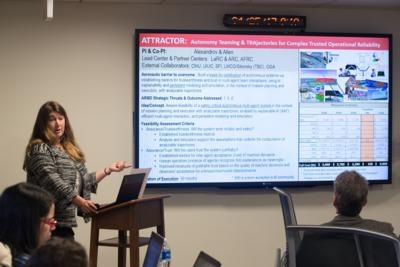Mon, Jun 12, 2017
Have All Conceptualized Solutions For Parts Of The UAS 'Puzzle'
Three teams of NASA researchers who have dreamed up potential solutions for pieces of the Unmanned Aircraft Systems (UAS) puzzle have received the nod to officially begin formal feasibility studies of their concepts.

The trio of investigations are part of NASA’s Convergent Aeronautics Solutions (CAS) project and are expected to take between 24 and to 30 months to complete.
“Our idea is to invest a very modest amount of time and money into new technologies that are ambitious and potentially transformative,” said Richard Barhydt, NASA’s acting director of the Transformative Aeronautics Concepts Program (TACP). “They may or may not work, but we won’t know unless we try.”
The studies will explore whether and how it might be possible to:
- Build a path toward safe inclusion and certification of autonomous systems in aviation. Autonomous systems, such as self-driving cars and future UAS, rely on learning algorithms that adapt to new goals and environments. The idea is to develop autonomy-enabling algorithms that lay a foundation for establishing justifiable confidence in machine decisions and, ultimately, lead to certification of autonomous systems.
- Develop new methods and technologies for a remotely-piloted drone to make sure it’s “fit to fly” before every single flight. The idea is to verify the aircraft is structurally and mechanically sound, and that all its onboard systems have not been damaged or hacked in some way. If it’s not sound, the aircraft will ground itself.
- Use quantum computing and communication technology to build a secure and jam-free network capable of accommodating hundreds of thousands of drones flying each day. Because of the manner in which data is organized and processed, quantum computing enables certain computations and communications to be done much more efficiently than a regular computer. For example, quantum computers may be able to solve certain problems in a few days that would take millions of years on the average computer.
The three studies were selected by a team of NASA aeronautics managers, led by recently retired TACP Director Doug Rohn, who made their decisions after hearing proposals offered by the principal investigators.
To be considered, research teams had to form on their own, represent multidisciplinary talents, and have members from more than one of NASA's aeronautics centers in Virginia, California and Ohio.
The three selected proposals join five that were selected in 2016 and six that were selected in 2015.
(Image provided with NASA news release. Principal Investigator Natalia Alexandrov makes the pitch to a group of NASA aeronautics managers for her team’s study, ATTRACTOR, which will explore how to embed reliability into algorithms that are used over time to inform autonomous systems in aviation)
More News
Also: Vertical Flight Society, NBAA Maintenance Conference, GA Honored, AMT Scholarship For the first time, students from Embry-Riddle’s Daytona Beach, Florida, campus took t>[...]
Hazardous Weather Information Summary of significant meteorological information (SIGMET/WS), convective significant meteorological information (convective SIGMET/WST), urgent pilot>[...]
"The need for innovation at speed and scale is greater than ever. The X-62A VISTA is a crucial platform in our efforts to develop, test and integrate AI, as well as to establish AI>[...]
(FAA) Inspector Observed That Both Fuel Tanks Were Intact And That Only A Minimal Amount Of Fuel Remained In Each Analysis: According to the pilot, approximately 8 miles from the d>[...]
“Pyka’s Pelican Cargo is unlike any other UAS solution on the market for contested logistics. We assessed a number of leading capabilities and concluded that the Pelica>[...]
 Airborne-Flight Training 05.09.24: ERAU at AIAA, LIFT Diamond Buy, Epic A&P
Airborne-Flight Training 05.09.24: ERAU at AIAA, LIFT Diamond Buy, Epic A&P ANN's Daily Aero-Term (05.07.24): Hazardous Weather Information
ANN's Daily Aero-Term (05.07.24): Hazardous Weather Information Aero-News: Quote of the Day (05.07.24)
Aero-News: Quote of the Day (05.07.24) NTSB Final Report: Cessna 150
NTSB Final Report: Cessna 150 Aero-News: Quote of the Day (05.08.24)
Aero-News: Quote of the Day (05.08.24)



